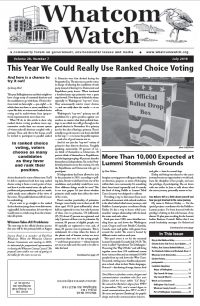1. Background: The Bellingham Municipal Code 13.16 outlines city regulations for 5G small cell installations. These were drafted in response to a 2018 City Council vote to support 5G installs. On January 14, 2019, new FCC regulations went into effect denying local municipalities the right to refuse 5G installations. So, Bellingham is set to proceed, yet there is an increasing outcry nationally and globally about the lack of scientific testing for safety, environmental effects, security and privacy issues. There is strong scientific basis for all these concerns. Some cities and states are suing against the FCC overreach. The Portland mayor refuses to proceed on the basis of health safety concerns, as well as FCC overreach.
What is your stance on supporting 5G installation in Bellingham?
I have been watching this 5G discussion and implementation plan, closely. There is global controversy on where 5G is going to come from, it could be a few years before we can implement I know there are mixed reviews on 5G. It can do some pretty amazing things however there are health concerns. When this starts to be a reality there will be more data and possibly policy changes. I will make an educated decision on the current available information.
2. Background: The current Bellingham Comprehensive Plan envisions that future population growth will find housing in high-density urban villages. How best to provide additional housing in the city is an ongoing discussion. For example, new city code now permits backyard dwelling units.
Do you favor permitting multifamily housing, like triplexes, in areas of the city now zoned exclusively for single-family, detached homes?
No one enjoys the growing pains of a community and not every location and neighborhood are appropriate for every housing type. However, the fact is, to meet our GMA population projection of accommodating 36,000 more people in 20 years, we need changes. Density is necessary, smart growth, not sprawl with all options on the table, ADU’s, multi-family, tiny homes and triplexes. Furthermore, studies show that some of the best tools to fight income inequality and environmental impacts on vulnerable populations stem from exclusionary zoning. Let’s focus on urban villages, growing up not out and allow neighborhoods to take some infill.
3. Background: Until 2012, the Mayor’s Neighborhood Advisory Commission, composed of representatives from every neighborhood, was by city code a party to the planning process which included review and comments on the city’s Comprehensive Plan and the individual neighborhood plans. Comments and recommendations from the Neighborhood Advisory Commission were submitted for consideration to the Planning Commission. In 2012, the city council, at the behest of the mayor, removed the Neighborhood Advisory Commission from the city’s planning process, thus eliminating neighborhoods from the planning process.
Would you be supportive of restoring, by city code, the role of the Mayor’s Neighborhood Advisory Commission in the process of updating the city’s comprehensive and neighborhood plans?
We encourage all persons and neighborhood associations to submit recommendations to be reviewed and considered through the planning process with the Planning Commission. Neighborhoods have not been eliminated, our current codes ensure inclusion to everyone, and streamlines the process. I support the current process and believe it is where people should be involved. Everything is on record and everyone gets to participate, it is the most public and transparent way to include community input. As your mayor, I commit to investing in public participation through all city channels to make sure everyone has a seat at the table.
4. Background: “Transportation is the largest source of greenhouse gas emissions in Bellingham, making up 32 percent of all community emissions.” (From the Bellingham Climate Action Plan.)
In recent years, Bellingham has made progress toward an active transportation network that helps reduce our carbon footprint as well as families’ transportation costs. More people are able to get where they need to go by walking, pedaling, and rolling (such as wheelchairs).
However, the connections for safe and active transportation are a long way from being complete, due to U.S. transportation planning that has for decades prioritized the movement of motor vehicles.
What transportation planning and funding solutions will you champion to accelerate both Bellingham’s reduction of carbon emissions and progress toward a safe and connected active transportation system for all ages and abilities?
We need to step up our public transportation, provide multi-modal transportation and electrify our transportation systems. We need electric buses, bikes, scooters and charging stations at municipal buildings, parks and grocery stores. I will be championing the renewal of the Transportation Benefit District, but also leveraging my statewide connections to advocate for funds from the legislature and our utility providers to fund the infrastructure we need. We have spent the last 100 years subsidizing the combustion engine as our main method of transportation. It is past time to try alternative methods that are greener, safer and support our community values.
5. Background: Mayor Linville has proven to be very pro-development, and, despite some sporadic and largely bureaucratic interest in the topics, has not carved out a legacy of environmental stewardship in this era of species extinction and climate change. Some nations and municipal jurisdictions, in response to environmental chaos, are currently declaring a “climate emergency.”
If you were to use your position to declare a “climate emergency,” what specific actions would accompany it, and where would you foresee the most pressing need for change in order for Bellingham to survive the threats we are facing?
I’ve spent the last 13 years of my career working on energy efficiency, renewables and carbon reduction. As a councilmember, I’ve used that knowledge to champion the Bellingham Energy Prize, updating our Climate Action Plan and co-authoring the resolution to create the Climate Action Task Force to set renewable energy targets. As mayor I will invest in energy reduction in our buildings, solar panels on our roofs, and electric fleet vehicles. I’ll add charging stations to our parks and public infrastructure. I bring a solid record of results on this issue and understand the gravity of the challenge facing us.
6. Background: For businesses to be effective in our information-intensive economy, they need bandwidth delivered on a fiber-optic infrastructure, which provides speed and reliability. Bellingham city government has not yet made the commitment to pursue an effective fiber-optic infrastructure that is offered as an open-access network, giving co-ops, as well as telecoms, access. Doing so would attract new businesses and would provide a wider variety of internet options for existing businesses and residents. We have our neighbor, Mt. Vernon, as a model for success in doing this.
Do you feel that identifying the city’s current network, and adding to it as necessary to create a reliable fiber infrastructure is a priority?
Yes, I’ve been exploring public fiber for the last few years. Liliquist and I met with Mt.Vernon, then requested a dig-once policy to be assessed by public works. Their recommendation was, it was too expensive for us to implement. Our network is extensive, and businesses are using it, however it’s too expensive for most small business to afford. I am in favor of implementing dig once and open-access at the city level. I’m impressed with the port’s lead of putting public fiber throughout the county. When everyone has high-speed quality access to the digital world, we all benefit.





























